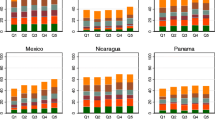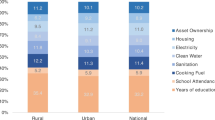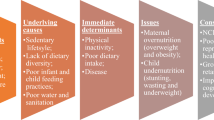Abstract
Background Reliable measurement of socioeconomic status (SES) in health research requires extensive resources and can be challenging in low-income countries. We aimed to develop a set of maternal SES indices and investigate their associations with maternal and child health outcomes in rural Yemen. Methods We applied factor analysis based on principal component analysis extraction to construct the SES indices by capturing household attributes for 7295 women of reproductive age. Data were collected from a sub-national household survey conducted in six rural districts in four Yemeni provinces in 2008–2009. Logistic regression models were fitted to estimate the associations between the SES indices and maternal mortality, spontaneous abortion, stillbirth, neonatal and infant mortality. Results Three SES indices (wealth, educational and housing quality) were extracted, which together explained 54 % of the total variation in SES. Factor scores were derived and categorized into tertiles. After adjusting for potential confounding factors, higher tertiles of all the indices were inversely associated with spontaneous abortion. Higher tertiles of wealth and educational indices were inversely associated with stillbirth, neonatal and infant mortality. None of the SES indices was strongly associated with maternal mortality. Conclusion By subjecting a number of household attributes to factor analysis, we derived three SES indices (wealth, educational, and housing quality) that are useful for maternal and child health research in rural Yemen. The indices were worthwhile in predicting a number of maternal and child health outcomes. In low-income settings, failure to account for the multidimensionality of SES may underestimate the influence of SES on maternal and child health.
Similar content being viewed by others
References
Van Bodegom, D., May, L., Kuningas, M., Kaptijn, R., Thomése, F., Meij, H. J., et al. (2009). Socio-economic status by rapid appraisal is highly correlated with mortality risks in rural Africa. Transactions of the Royal Society of Tropical Medicine and Hygiene, 103(8), 795–800.
Krieger, N., Williams, D. R., & Moss, N. E. (1997). Measuring social class in US public health research: concepts, methodologies, and guidelines. Annual Review of Public Health, 18, 341–378.
Braveman, P. A., Cubbin, C., Egerter, S., et al. (2005). Socioeconomic status in health research: one size does not fit all. JAMA, 294, 2879–2888.
Fotso, J.-C., & Kuate-Defo, B. (2005). Measuring socioeconomic status in health research in developing countries: should we be focusing on households, communities or both? Social Indicator Research, 72, 189–237.
Shavers, V. L. (2007). Measurement of socioeconomic status in health disparities research. Journal of the National Medical Association, 99, 1013–1023.
United States Census Bureau. (2007). US Census Bureau. Washington, DC, cited June 10 2014 http://www.census.gov.
Krieger, N., Chen, J. T., & Ebel, G. (1997). Can we monitor socioeconomic inequalities in health? A survey of health departments’ data collection and reporting practices. Public Health Reports, 112(6), 481–491.
Williams, D. R. (1997). Race and health: basic questions, emerging directions. Annals of Epidemiology, 7(5), 322–333.
Navarro, V. (1990). Race or class versus race and class: mortality differentials in the United States. Lancet, 336, 1238–1240.
Braveman, P., & Cubbin, C. (2003). Optimal SES indicators cannot be prescribed across all outcomes. American Journal of Public Health, 93(1), 12–13.
Jean.-Christophe, F., & Kuate-Defo, B. (2005). Measuring socioeconomic status in health research in developing countries: Should we be focusing on households, communities or both? Social Indicators Research, 72, 189–237.
Nwaru, B. I., Klemetti, R., Kun, H., Hong, W., Yuan, S., Wu, Z., et al. (2012). Maternal socio-economic indices for prenatal care research in rural China. Eur J Public Health, 22(6), 776–781.
Meier, E., & Moy, C. (1999). Social Classifications—a new beginning or less of the same? Journal of the Market Research Society, 41(2), 135–151.
Oakes, J. M., & Rossi, P. H. (2003). The measurement of SES in health research: Current practice and steps toward a new approach. Social Science and Medicine, 56, 769–784.
Smith, E. A., Mulder, M. B., Bowles, S., & Hill, K. (2011). Wealth inequality in foraging, horticultural, pastoral, and agricultural populations. Current Anthropology, 52(4), 579–580.
Babalola, S., & Fatusi, A. (2009). Determinants of use of maternal health services in Nigeria—looking beyond individual and household factors. BMC Pregnancy Childbirth, 15(9), 43.
Ministry of Health and Population & UNICEF. (2008). Yemen multiple indicator cluster survey 2006. Yemen: Ministry of Health and Population.
Vyas, S., & Kumaranayake, L. (2006). Constructing socio-economic status indices: how to use principal components analysis. Health Policy Plan, 21, 459–468.
Rossi, P. H., & Berk, R. A. (1985). Varieties of normative consensus. American Sociological Review, 50, 333–334.
Macintyre, S., & Ellaway, A. (2000). Ecological approaches: Rediscovering the role of physical and social environment. In L. F. Berkman & I. Kawachi (Eds.), Social Epidemiology (pp. 322–348). New York: Oxford University Press.
Kawachi, I., Subramanian, S. V., & Almeida-Filho, N. (2002). A glossary for health inequalities. Journal of Epidemiology and Community Health, 56(9), 647–652.
Ford, G., Ecob, R., Hunt, K., Macintyre, S., & West, P. (1994). Patterns of class inequality in health through the lifespan: class gradients at 15, 35, and 55 years in the west of Scotland. Social Science and Medicine, 39, 1037–1050.
Cubbin, C., LeClere, F. B., & Smith, G. S. (2000). Socioeconomic status and the occurrence of fatal and nonfatal injury in the United States. American Journal of Public Health, 90, 70–77.
Acosta, A. A., Cabezas, E., & Chaparro, J. C. (2000). Present and future of maternal mortality in Latin America. International Journal of Gynaecology and Obstetrics, 70, 125–131.
Rogelio, G., Jennifer, H. R., Jyh, K. N., Mario, M., Flavia, B., & Ana Pilar, B. (2009). Tackling Health Inequities in Chile: Maternal, Newborn, Infant, and Child Mortality Between 1990 and 2004. American Journal of Public Health, 99(7), 1220–1226.
Loudon, I. (1992). The transformation of maternal mortality. BMJ, 305, 1557–1560.
Wong, E. Y., Ray, R., Gao, D. L., Wernli, K. J., Li, W., Fitzgibbons, E. D., et al. (2010). Physical activity, physical exertion, and miscarriage risk in women textile workers in Shanghai China. American Journal of Industrial Medicine, 53(5), 497–505.
Jones, R. K., Darroch, J. E., & Henshaw, S. K. (2002). Patterns in the socioeconomic characteristics of women obtaining abortions in 2000–2001. Perspectives on Sexual and Reproductive Health, 34(5), 226–235.
Henshaw, S. K., & Silverman, J. (1988). The characteristics and prior contraceptive use of U.S. abortion patients. Family Planning Perspectives, 20(4), 158–159, 162–168.
Salvini, S., & Schifini, S. (1996). Induced abortion in Italy: levels, trends and characteristics. Family Planning Perspectives, 28, 267–271.
Helström, L., Zättersröm, C., & Odlind, V. (2006). Abortion rate and contraceptive practices in immigrant and Swedish adolescents. Journal of Pediatric and Adolescent Gynecology, 19(3), 209–213.
Huang, D. Y., Usher, R. H., Kramer, M. S., Yang, H., Morin, L., & Fretts, R. C. (2000). Determinants of unexplained antepartum fetal deaths. Obstetrics and Gynecology, 95, 215–221.
Joyce, R., Webb, R., & Peacock, J. (1999). Social class and census-based deprivation scores: which is the best predictor of stillbirth rates? Paediatric and Perinatal Epidemiology, 13, 269–277.
Olsen, O., & Madsen, M. (1999). Effects of maternal education on infant mortality and stillbirths in Denmark. Scand J Public Health, 27, 128–136.
Aleli, D. K., Kim-Huong, N., Jimenez-Soto, E., & Andrew, H. (2013). Stagnant neonatal mortality and persistent health inequality in middle-income countries: A case study of the Philippines. PLoS One, 8(1), e53696.
Zere, E., Oluwole, D., Kirigia, J. M., Mwikisa, C. N., & Mbeeli, T. (2011). Inequities in skilled attendance at birth in Namibia: a decomposition analysis. BMC Pregnancy and Childbirth, 11, 34.
Aditya, S., Abhishek, K., & Amit, K. (2013). Determinants of neonatal mortality in rural India, 2007–2008. PeerJ, 1, e75.
Amal, O. B., Ghada, H. I., Igbal, A. B., & Ishag, A. (2013). Neonatal mortality in Sudan: analysis of the Sudan household survey, 2010. BMC Public Health, 13, 287.
Amal, K. H., & Kabir, M. (2008). Child mortality inequalities and linkage with sanitation facilities in Bangladesh. Journal of Health Population Nutrition, 26(1), 64–73.
Jana, S. (2008). Poverty and infant mortality in the Eastern Mediterranean region: a meta-analysis. Journal of Epidemiology and Community Health, 62(8), 745–751.
Al-Hosani, H. A., Brebner, J., Bener, A. B., & Norman, J. N. (2003). Study of mortality risk factors for children under age 5 in Abu Dhabi. East Mediterr Health J, 9, 333–343.
Grant, C. J., & Bittles, H. A. (1997). The comparative role of consanguinity in infant and childhood mortality in Pakistan. Annals of Human Genetics, 61, 143–149.
Casterline, J. B., Cooksey, E. C., & Ismail, A. F. (1992). Infant and child mortality in rural Egypt. Journal of Biosocial Science, 24, 245–260.
Durrant, V. L., & Sathar, Z. A. (2000). Greater Investments in Children Through Women’s Empowerment: A Key to Demographic Change in Pakistan? Population Council, New York. Cited June 23 2014 http://www.populationcouncil.com/uploads/pdfs/wp/137.pdf.
Mahmood, M. A. (2004). Determinants of neonatal and post-neonatal mortality in Pakistan. The Pakistan Development Review, 41(4), 723–744.
Zanini, R. R., Moraes, A. B., Giugliani, E. R., & Riboldi, J. (2011). Contextual determinants of neonatal mortality using two analysis methods, Rio Grande do Sul, Brazil. Revista de Saúde Pública, 45(1), 79–89.
Rath, S., Nair, N., Tripathy, P. K., Barnett, S., Rath, S., Mahapatra, R., et al. (2010). Explaining the impact of a women’s group led community mobilisation intervention on maternal and newborn health outcomes: the Ekjut trial process evaluation. BMC International Health and Human Rights, 10, 25.
Acknowledgments
The authors acknowledge the local midwives and healthcare workers for taken part in the study survey and contacted the interviews. Thanks are due to staff at the governorate health offices. Also the authors acknowledge UNICEF Yemen office for granting us permission to use the HBMNC 2008–2009 survey data for this study. Financial assistance for the survey came from the UNICEF Yemen office and Ministry of health, Yemen.
Authors’ Contribution
This article was designed, analyzed and written by Alosaimi Abdullah under the supervision of Riitta Luoto and Bright Nwaru. Alserouri Abdelwahed, and Halima Mouniri did the surveys in the provinces. All authors commented and approved the final version of the manuscript.
Author information
Authors and Affiliations
Corresponding author
Appendices
Appendix 1
See Table 5.
Appendix 2
See Table 6.
Appendix 3
See Table 7.
Rights and permissions
About this article
Cite this article
Alosaimi, A.N., Luoto, R., Al Serouri, A.W. et al. Measures of Maternal Socioeconomic Status in Yemen and Association with Maternal and Child Health Outcomes. Matern Child Health J 20, 386–397 (2016). https://doi.org/10.1007/s10995-015-1837-4
Published:
Issue Date:
DOI: https://doi.org/10.1007/s10995-015-1837-4




